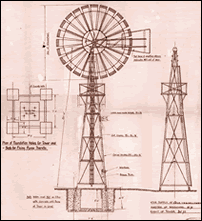
Producing electricity
from wind is a new industry; there was no commercial wind power in Europe
until the 1980’s. Wind energy technology is still developing and the
wind turbines are becoming more efficient, cheaper and with increasing capacity.
Civil, electrical, electronic and mechanical engineers are all playing a
role in this area. Windfarms are sites with a group of wind turbines generating
electricity on a significant scale.
|
|

- Renewable energy
source
- No greenhouse gases
(which contribute to global warming)
- No sulphur dioxide
emissions (which are a cause of acid rain)
- No harmful emissions
/ wastes (gas, liquid or solid)
- Positive impact
on Ireland’s Balance of Payments
|
|

 
Windmills were introduced
into Ireland by the Anglo-Normans. The earliest Irish windmill at Kiscalan,
Co. Wexford is known to have been in existence in 1281. In 1585 a windmill
is known to have been in existence at Galway.
Between then and the early years of the 19th century there were at least
twenty-four windmills in Co. Galway. By the late 19th century wind power
was used to pump water on large estates.
During the 1920's and the 1930's Maurice Sweeney B.E. built at least 13
wind powered public water schemes for Galway County Council.
During the 1950's a major survey was undertaken on the potential for electricity
generation from wind power in Ireland. Two sites were investigated in Co.
Galway, one at Roundstone, the other being the Aran Islands.

At the beginning of 2000 there were 10 windfarms in operation in Ireland
with 70 MW of installed capacity and producing just over 1% of Ireland’s
electricity. All of these plants are located in the West and North West
with the exception of one site in Cork.
The first significant wind energy installation in Ireland was the windfarm
at Bellacorick, Co. Mayo, built in 1992 on a site adjacent to a turf power
station.
There are other wind energy projects in the West of Ireland at the planning
or construction stage. The
West of Ireland is well positioned to play a significant role in the development
of this industry, which is still in its infancy. The West coast of Ireland,
along with Scotland, has the highest wind speeds in Europe. Wind speed is
all important e.g. a turbine on a site with average wind speed of 8 m/sec
will produce 80% more electricity than one on site with wind speed of 6m/sec.
|
|
| |
 
Rotor
– Generally consists of 3 glass fibre reinforced polyester blades
connected to a hub on a horizontal shaft, which rotates at 15 to 30 RPM.
Nacelle
- Contains the key components of the wind turbine, including gearbox,
electrical generator and control systems. Service personnel can enter
the nacelle from the tower of the turbine.
Tower
- Towers are mostly cylindrical (or polygonal) and made of steel, generally
painted light grey. It is an advantage to have a high tower, since wind
speeds increase farther away from the ground.
The yaw mechanism is located between the top of the tower and nacelle
and uses electrical motors to turn the nacelle and rotor to face the wind.
The tower incorporates access ladders and electrical cables.
Base
– Consists of large reinforced concrete structure, buried underground.
|
|

 |
 |
 |
 |
 |
| |
Parameter |
Value |
Units |
|
| |
Height |
25-80 |
m |
|
| |
Diameter |
30-65 |
m |
|
| |
Turbine size |
2.0 |
MW |
|
| |
Turbine size |
0.6 |
MW |
|
| |
Start-up wind speed |
4 - 5 |
m/sec |
|
| |
Optimum wind speed |
15 |
m/sec |
|
| |
Cut-out speed |
25 |
m/sec |
|
|

